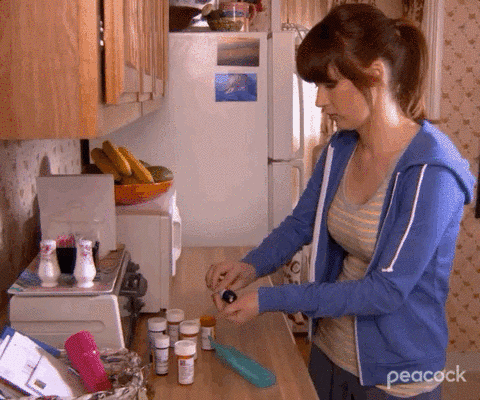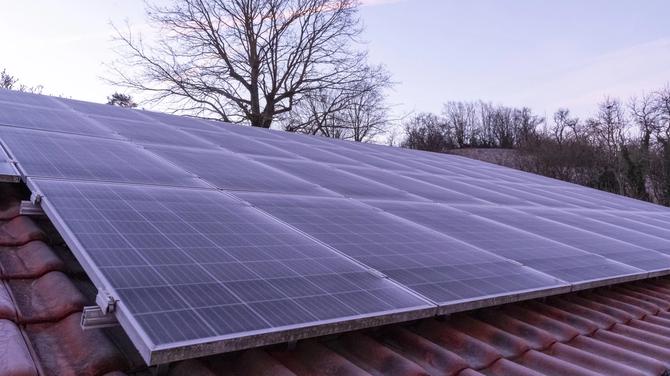🐤 Minimalized medicine
We're taking more medication than ever before ... and it's becoming an issue.
| Tuesday | April 23rd, 2024 | |
 | |
Together With
 | |
Happy Tuesday, chirpers! We’re always honored to be part of your daily routine … and if you find yourself more rushed than usual after the alarm goes off, there are a few ways you can get the most out of your mornings. Brushing your teeth while showering might sound strange, but it can shave a couple of minutes from the time it takes to get ready. Laying out your clothes the night before is another great morning time-saver. And if you can’t make it to the gym, consider getting some stretches in while your coffee is brewing. -Chris Agee Markets
NASDAQ
IXIC $15,451.31
$169.30 (1.11%) Dow Jones
DJI $38,239.98
$253.58 (0.67%) S&P 500
GSPC $5,010.60
$43.37 (0.87%) EUR-USD
EURUSD $1.07
-$0.00 (-0.03%) Bitcoin
BTC-USD $67,081.07
$2,154.43 (3.32%) Virgin Galactic
SPCE $0.75
-$0.10 (-12.17%) 🏦 Markets: Another week, another direction for Wall Street. After a prolonged stock slump ate away at some of the gains of previous months, investors got a reprieve yesterday with the major indexes ticking up over the course of the day. The Nasdaq Composite led the way with an increase of more than 1% on the strength of a rallying tech industry. Verizon kicked off the week’s corporate earnings data with an impressive report and other major companies — Tesla, Meta, and Visa, among others — will be dropping their reports in the coming days. World
The BreakdownA quick look around the world. NASA illustration
NASA illustration
🚀 Near miss: Space debris is a necessary byproduct of our current age of exploration, but experts still want to keep the amount of junk orbiting the Earth to a minimum. According to recent reports, one potentially devastating collision nearly resulted in a big mess resulting in a huge trail of space junk. NASA’s TIMED spacecraft narrowly avoided a collision with Russia’s retired Cosmos 2221 in February. At the time, observers said it was “too close for comfort,” but new data shows that the two satellites came even closer than anyone initially thought. 🪧 Remote learning: Years after classes were canceled far and wide due to the threat of COVID-19, in-person lectures at Columbia University were halted this week for a much different reason. The New York campus has been a hotbed of pro-Palestinian protests in recent days, leading to arrests and concerns regarding how to ensure that students and staff can remain safe in the increasingly volatile environment. Similar, if smaller, demonstrations have also erupted at other colleges including the Massachusetts Institute of Technology. 📦 Droning on: For years, many tech insiders assumed that the use of unmanned drones would be the next logical step in speedy home delivery, and Amazon was at the forefront of this evolution with its roll-out of “Prime Air” deliveries on a trial basis in Lockeford, California. This week, however, the online retail giant confirmed that it would be curtailing the program without offering details about the apparent snag in its progress. Prime Air is still in operation elsewhere, including College Station, Texas, and Tolleson, Arizona. 🚈 Speedy travels: The United States’ most ambitious investment in high-speed rail is officially underway with construction set to begin on a line linking Las Vegas and Los Angeles. The project, which is expected to cost somewhere around $12 billion and become operational by 2028, was touted by the Biden administration. “People have been dreaming of high-speed rail in America for decades,” said Transportation Secretary Pete Buttigieg. “It’s really happening this time.” A similar project is in the works in Florida, aiming to connect Orlando and Miami. Share this issue:Together With Masterworks
This market with 63% price growth isn't just for billionaires anymore…Join an exclusive community investing in blue-chip art
Over the last 20 years, record prices achieved for Banksy’s art have grown at an astounding 63% compound annual rate. Even more impressive? It's not just the ultra-wealthy benefiting from this phenomenal growth. Thanks to Masterworks. Masterworks enables its 820,000+ users to access investments in multi-million dollar artworks by artists like Banksy, Basquiat, and Picasso for just a fraction of the cost of an entire piece. When Masterworks sells a painting, like the 16 it’s already sold, investors can get a return on their investment. With 3 recent sales, Masterworks investors realized net annualized returns of 17.8%, 21.5% and 27.3%. Every offering is limited, and shares can sell out in just minutes, but Early Chirp readers can skip the waitlist with this exclusive link. health
The Mounting Case Against (Too Much) MedicationInteractions between prescription drugs can cause some serious side effects. Giphy
Giphy
Modern healthcare is objectively impressive, with scientists, doctors, and other specialists working all the time to develop new treatments for ailments that have plagued humans for centuries. But the flip side to that progress is that more people are taking more prescription drugs than ever before. And that’s not always a good thing. Potentially harmful combinations According to the Centers for Disease Control and Prevention, about 20% of adults between the ages of 40 and 79 take at least five different prescription medications. Many of those on the older end of that spectrum take even more. This trend even has a name — polypharmacy — and while it can be helpful in treating serious diseases, there’s also the possibility that interactions between these drugs can cause a whole new set of problems. Researchers have found that an increase in the number of medicines a person takes can result in higher rates of issues including:
This data has resulted in a growing trend among healthcare professionals who advise patients to re-evaluate their pharmaceutical cocktails and scale back where feasible. How to take appropriate action If you or someone you love is currently taking several different prescriptions, you might understandably be concerned about the way they’re interacting with each other. But doctors and pharmacists alike are wary about when and how to curtail the use of prescribed medications. The best course of action for a patient involves regular evaluations with a primary care physician who can monitor health trends and answer questions. If you’re not sure how to voice your concerns, consider asking whether some of your symptoms might be side effects from your prescriptions or if it’s possible to address certain health problems with changes in lifestyle instead of additional medication. Share this story:business
Are You Overwhelmed By Customer Satisfaction Surveys? You’re Not Alone.Worse yet, these intrusive questionnaires might not even be doing any good. Giphy
Giphy
In bygone generations, businesses sought to provide excellent products and courteous service, relying on word of mouth and repeat customers as an indication that they were doing a good job. But now, self-assessment has largely been replaced by online surveys. It’s not just hotels and restaurants that are keen on asking customers whether they were satisfied … increasingly, doctor’s offices, insurance companies, and other professional service providers are using surveys to gauge their performance. Is it even working? You’d think that with all this feedback coming in, businesses would take heed of opportunity for improvement and customer satisfaction would generally be on the upswing. Instead, some evidence shows that when average consumers are compelled to constantly evaluate their experiences, they end up feeling overloaded and often don’t take the time to consider their responses before submitting surveys. Making matters worse, many of these surveys completely skim over the central component of any business transaction: whether the customer received a high-quality product or service. More often, we’re asked about the experience, i.e., whether a menial employee was friendly rather than whether a massive corporation is doing its job effectively. It’s only getting worse Market research is big business, as evidenced by a host of research data showing just how much money is being poured into customers satisfaction surveys:
But fewer customers are actually using surveys to complain, says Qualtrics executive Brad Anderson, explaining: “When a customer has a poor experience, 10% fewer of them are telling the company about it than they did in 2021. What’s happening is they’re just switching.” Share this story:energy
Too Much Power: The Downside Of California’s Solar Panel BoomOther states are headed in the same direction. Shutterstock
Shutterstock
Driving through just about any neighborhood across the nation’s most populous state will reveal a host of homes rocking solar panels on their roofs. And this makes sense, of course. After all, not only are Californians generally interested in prioritizing renewable resources, but there’s also just a heck of a lot of sunshine there. But could there actually be too many panels contributing to the state’s power grid? On the surface, it might sound like an absurd question … but it’s one that experts are seriously asking. Solar energy by the numbers There are new panels being added everyday, so it’s hard to find up-to-date statistics, but the most recent data available indicates that the state churns out almost 47 gigawatts of solar power. That’s enough to provide power to almost 14 million homes and it currently accounts for more than 25% of the state’s electricity output. So what’s the problem? In a nutshell: springtime. The sun is out and the temperature is moderate, meaning energy supply is significantly higher than demand. This creates a scenario in which the cost of electricity is effectively below zero and some of the solar energy is wasted. A nationwide trend emerges Other U.S. states are ramping up their installation of solar panels with incentives to homeowners who choose to add them to their property. But California’s lead might serve as a cautionary tale. Incentives in that state are being rolled back and the formerly furious embrace of solar panels is cooling off significantly. Solar energy is still a valuable resource, though, and researcher Michelle Davis says officials just need to figure out the right balance for their respective states. “These are not insurmountable challenges,” she advised. “But they are challenges that a lot of grid operators have never had to deal with.” Share this story:Game
Solve today's crossword and win a prize!Highest score wins an Amazon gift card!
*Prizes are sent out via email the next day by 11am EST. meme
 https://memes.com/u/robinhoodprinceofmemes
https://memes.com/u/robinhoodprinceofmemes
|

Written by Chris Agee 90 N Church St, The Strathvale House Copyright © 2022 Early Chirp. All rights reserved. |




